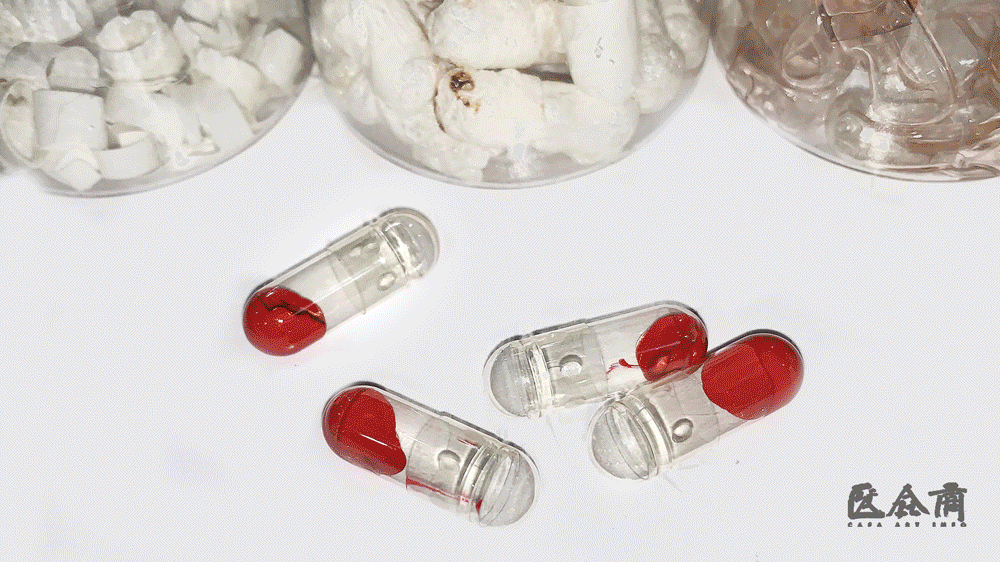
Editor’s note: The course “The Theoretical Constructs of Printmaking & Three Dimensional Art Creation” was conducted by tutor Zhang Zhandi together with the students from the second studio of the Printmaking Department. Participating students were open-minded and have achieved surprising and pleasant results. Varying from graphic paintings, installations, performances and videos, their creations overrode the limitation of “printmaking”, and used their diversified strategies to present the unique quality of the creative identity. With guidance on the common concept, these students were trying to find their own “printmaking genes”.
As teacher Zhang Zhandi said, “It would be absurd if the ‘strategy’ is not based on the understanding of tradition and the ontology of art.” What was worth mentioning was that in the introduction to the online class this time, in particular we presented the conversations between tutor Zhang Zhandi and the students, which helped us to directly access the classroom.
The Theoretical Constructs of Printmaking & Three Dimensional Art Creation
Targeting students: The third-year students from the second studio of the Printmaking Department
Duration: 2020.02.24—2020.04.17, eight weeks in total
Tutor: Zhang Zhandi
Participating students: Yan Ge, Gan Zhuo’an, Jia Min, Li Yuning, Hu Jingzheng, Xiao Yu, Dong Qi
About the Tutor

Zhang Zhandi
Since 2010, he has been teaching at the Printmaking Department of CAFA
2008 Graduated from the Department of Visual Arts, University of Massachusetts
2003 Graduated from the Printmaking Department of Central Academy of Fine Arts
He conducted courses around research into modernism art such as “Image and Meaning”, "The Theoretical Constructs of Printmaking & Three Dimensional Art Creation”, etc.
Intro of Online Class—The Theoretical Constructs of Printmaking & Three Dimensional Art Creation
Philosophy of the Curriculum
As we have seen, some Western postmodernist artists use apparently extreme and parochial unique techniques to express themselves. For example, the formalin solution used by Damien Hirst, or the fabric, casting, printmaking and other materials used by Kiki Smith. These diversified methods are all parochial because it is an artist's specific method. However, the extremes brought about by each “strategy” precisely reflect the unique identity of the creative individual. Ideal “post-modern” art is a continuation of “traditional” and “modern” art in its spiritual connotation—rather than diluting and shrinking their meanings, but the way of shaping meaning has completely shifted to individual cautious and wise decisions.
The course "The Theoretical Constructs of Printmaking & Three Dimensional Art Creation" expects students to discover more of their “printing genes”, and thus have a deeper understanding of their own characteristics. It is worth mentioning that the above-mentioned “strategies” would be absurd if they were not based on the understanding of traditions and the ontology of art.
Aim of the Curriculum
First of all, it is necessary to complete the discussion course which involves the ontological language of printmaking and the development of the notion of printmaking. The contents of discussion include Albrecht Dürer’s Virgin and Rhinoceros, the geographical discovery and the first corroded copper engraving, the avant-garde weapon in the Religious Reformation, the ripples of enlightenment and the power of machines, the giant of Faust and Goya, the appearance of “art catalogue” and Henri de Toulouse-Lautrec’s lithographs, Beckman in the First World War, as well as Andy Warhol and his friends.
Secondly, students are required to complete relevant practice. I adjusted the practice content due to the students’ study-at-home circumstances. In addition to printing-related content, students need to collect materials locally. I try to help everyone think about how to find materials that suit their own ideas in daily life and use them to modify, and then complete the work. Besides, according to the requirements of the subject, a considerable part of the course needs to be completed using a computer, which has not changed much from the norm but in the presentation of works as students need to display them in their own home remotely.
Practice, class discussion, and reading account for 40%, 30%, and 30% respectively of the score.
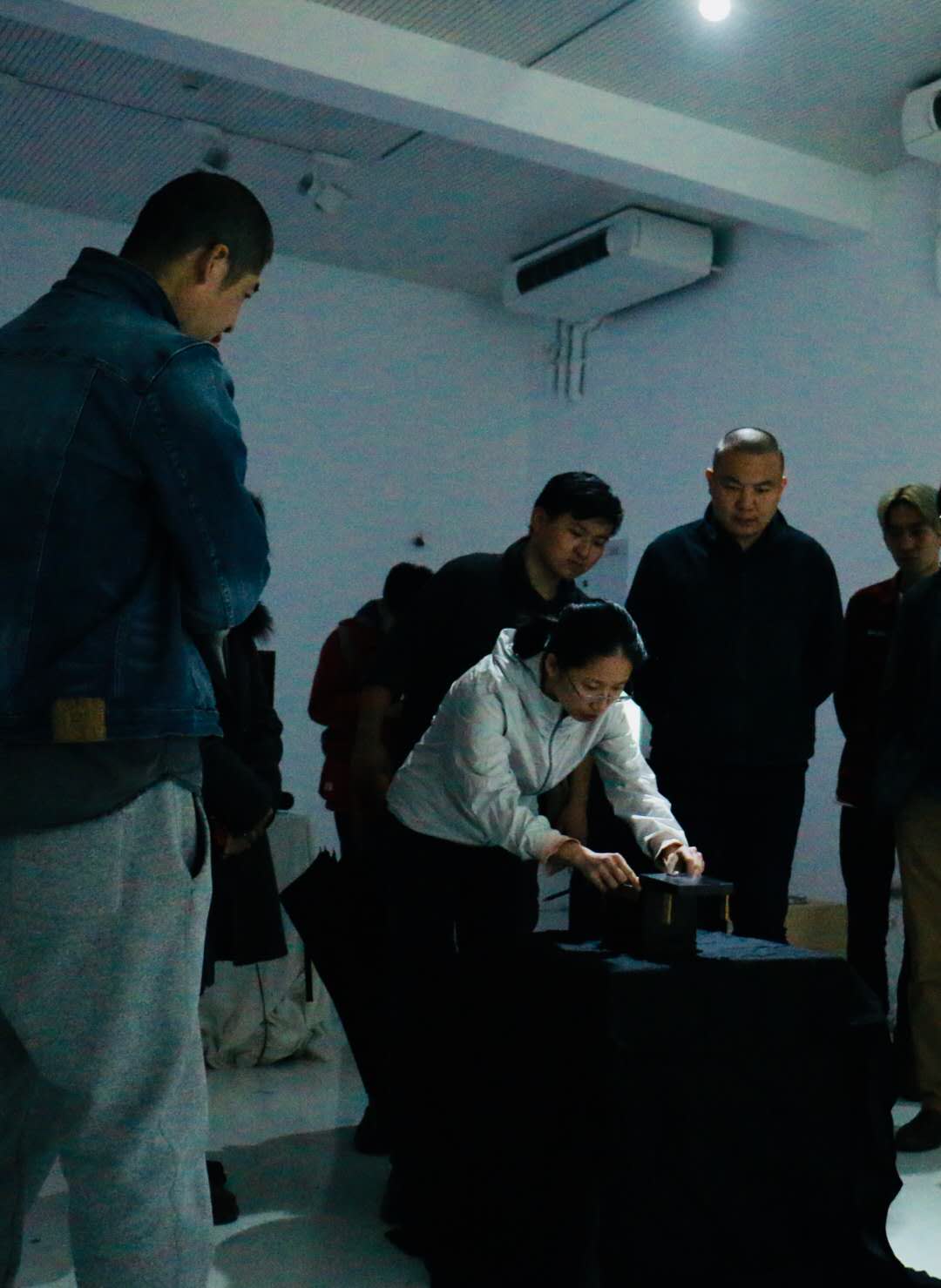


View of Previous Offline Classes
Contents of the Curriculum
1. The material and texture of three-dimensional space (2.24—3.6)
2. Dynamic and Plurality (3.9—3.20)
3. Space and Light (3.23—4.17)
The content of the course follows the courses of the first semester of the third grade, which focus more on the traditional art skills and thinking of printmaking. The purpose of this course, however, is to pay more attention to the research into the way of thinking that brings up by the unique artistic language of printmaking.
As we all know, modern society belongs to the age of mechanical reproduction. Printmaking is developed in such an environment. The characteristics such as plurality are brought about by the ontology of printmaking. In this course, the initial study of the inherent characteristics of printmaking and its practice on a wider range of artistic expressive techniques are conducted.
The Theory of the Curriculum
The starting point of this course is the understanding of “The Theoretical Constructs of Printmaking”. The main points are sorted out here and I hope to continue to revise them during the course.
The first is printing. It must be the information that is needed in a certain environment that can contribute to the printing behavior. The power of printing behavior lies in the behavior itself, which implies the spiritual energy of the printed matter. The duration of the printing behavior indicates the degree to which the printed information affects the audience.
The second is the print texture. There are four traditional printing methods, namely, concave, convex, flat and leaking. Except for the silk leaking method, which may not use paper as a carrier, the other three are all printed on paper from the perspective of traditional methods. The biggest function of paper-based printing is to facilitate reproduction. If we remove the reproducing function, what remains is the irreplaceability of texture brought about by different printing methods.
The third is the “plurality” developed from the notion of printmaking. The result of printmaking is to produce matters that share the same appearance. However, can all things with the same appearance have the title of being a print product? It is not the case actually. It is about the plurality that embodies in printmaking notion. The result of plurality is to produce many products which share the same appearance, however, products with the same appearance can be called reproductions. The power of plurality lies in the indifference between them.
The fourth one is the nature of pop in printmaking. As a printing method itself is not important here, whether it can achieve the possibility of dissemination becomes the fundamental goal.
Fifth, the scientific principles related to printmaking. Printmaking is a science and technology, and now there are countless scientific principles related to it, such as the acid corrosion principle, the photosensitive principle, and many other physical principles, which are all related to printing.
The use of “theoretical constructs of printmaking” can be applied in diverse forms and materials to expand the practice of printmaking. In this case, what features in this course is how to take “the theoretical constructs of printmaking” as the starting point to utilize relevant forms and materials to create three-dimensional art.

The Script of Online Teaching
(Edited in accordance with Tutor Zhang Zhandi’s interview)
From the beginning of school to the May Day holiday, I completed the eight-week basic course in the second year of the Printmaking Department, the ten-week studio course and the four-week cultural inspection course in the second studio. I think all teachers who conduct online teaching courses might have encountered similar problems. The biggest one is that, compared to offline courses, online teaching reduces the emotional and ideological communication between teachers and students. Incidental topics in the class, small chats after class, etc., these seemingly random contents are indispensable in college education.
I always imply that teaching is like drawing a picture. The visible things such as the image and content in the picture are like the specific content of the lecture, and the emotional communication between teachers and students, or the part taught by the teacher’s personal example, is like the texture, rhythm, style picture and other things that are not easy to find but are really behind the picture. A painting or teaching that only conveys “visible things” equals 60 points—it can be better. To make up for it, I increased the frequency of using WeChat to communicate with classmates one-on-one, and I found that chat is not good enough. Instead, typing is the best way for a deep conversation, but it's really tiring.
More than a decade ago, various universities in the United States began to engage in online education. Students can take online courses, watch videos recorded by professors, complete assignments and exams, and finally get credits. I felt that this way seemed good at the time. At the beginning of this year, I asked my colleagues in the United States what was the current development of online education there, and they replied that there was little progress and value. So I feel that online teaching will not have much impact and influence on traditional art education.
I participated in two classes on the Internet this spring. One was a lecture by Teacher Cao Xingyuan’s lecture on contemporary art via Tecent Video, and the other was by Teacher Bai Qianshen from Zhejiang University on calligraphy. Teacher Bai gave this class three times, which I benefited a lot from. I feel that it would be a good thing for academies to launch various video courses based on the experience of online courses during this pandemic. After all, we all agreed with the form of “Harvard Open Course” a few years ago, and we also have this strength. With everyone’s efforts, it will definitely achieve increasingly higher quality.
Conversations between Zhang Zhandi and the Students
Student Yan Ge
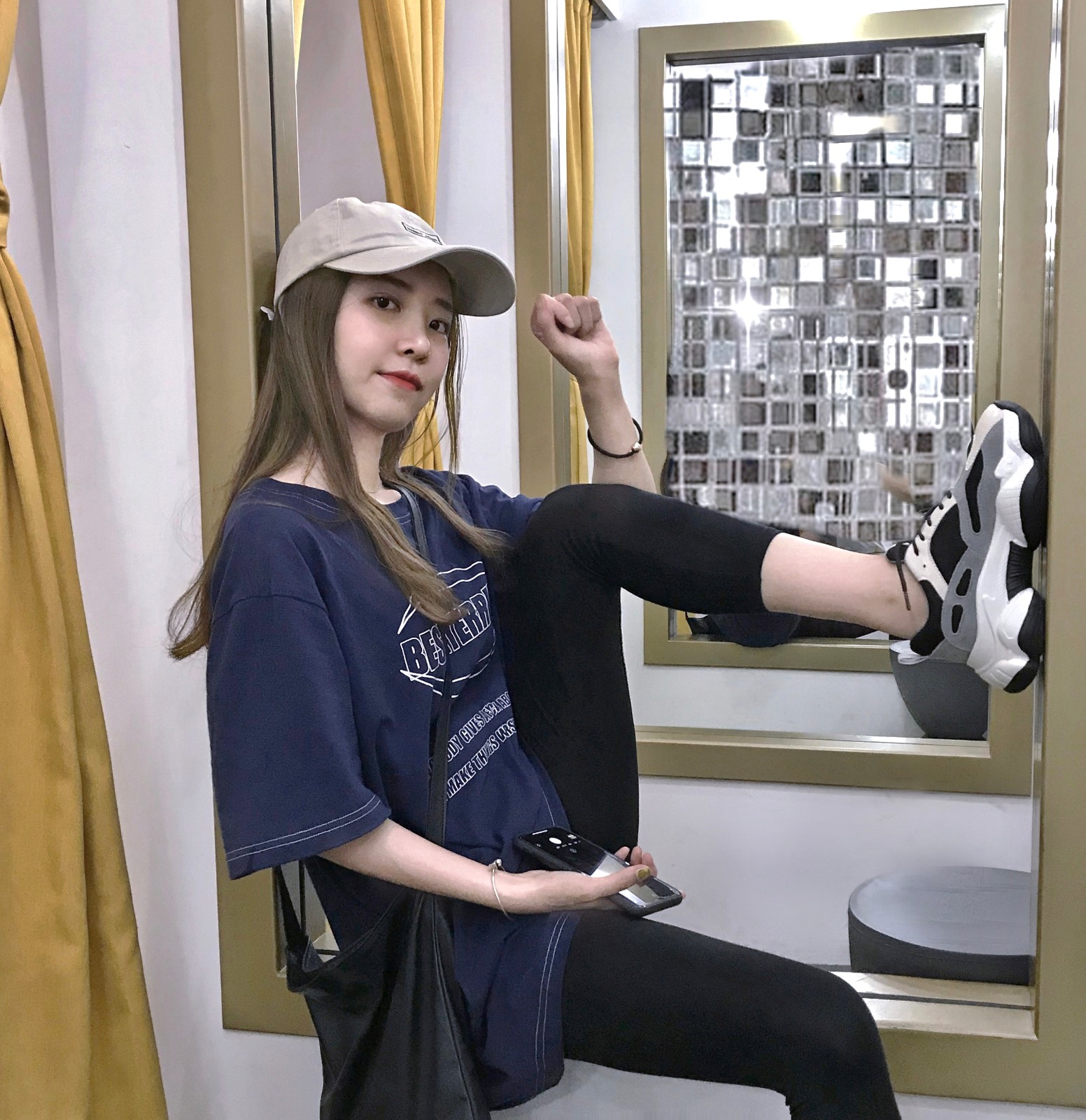
Zhang Zhandi: I just realized that although the material language in your two works becomes different, it shares some common meanings, or it shows the common quality in meaning and concept to some extent. Can we discuss and sort out their common features here?
Yan Ge: Yes, during the process of my creation, I have been pursuing “moderacy”. I hope that every viewer who encounters my works can capture their own emotions in my “calculations”. I think this is the best way to achieve healing. The comfort, warmth and purifying during the process of healing, are something that medicines cannot fully facilitate. The relationship between spirit and body and the development of human material civilization will force life to be more controlled by the spirit. Spirit is part of consciousness, and it also covers the psychological status of human beings, such as emotions and will, etc.. Moreover, the spirit is a direct reflection of a person’s vital signs, which leads to uncertainty and mutation. I think these are something that I would like to present to everyone at the very beginning.
During the communication with the teacher halfway through the completion of the work “Medicine”, I realized that the narrative of my work may be overshadowed by its texture, so I made some modifications and adjustments, focusing more on the form and conceptuality of the work. Various attempts have been made—burning, soaking, dripping wax, injecting liquid and tailoring, etc. All these methods have diversified the appearance and the work itself turns out to be increasingly plump.




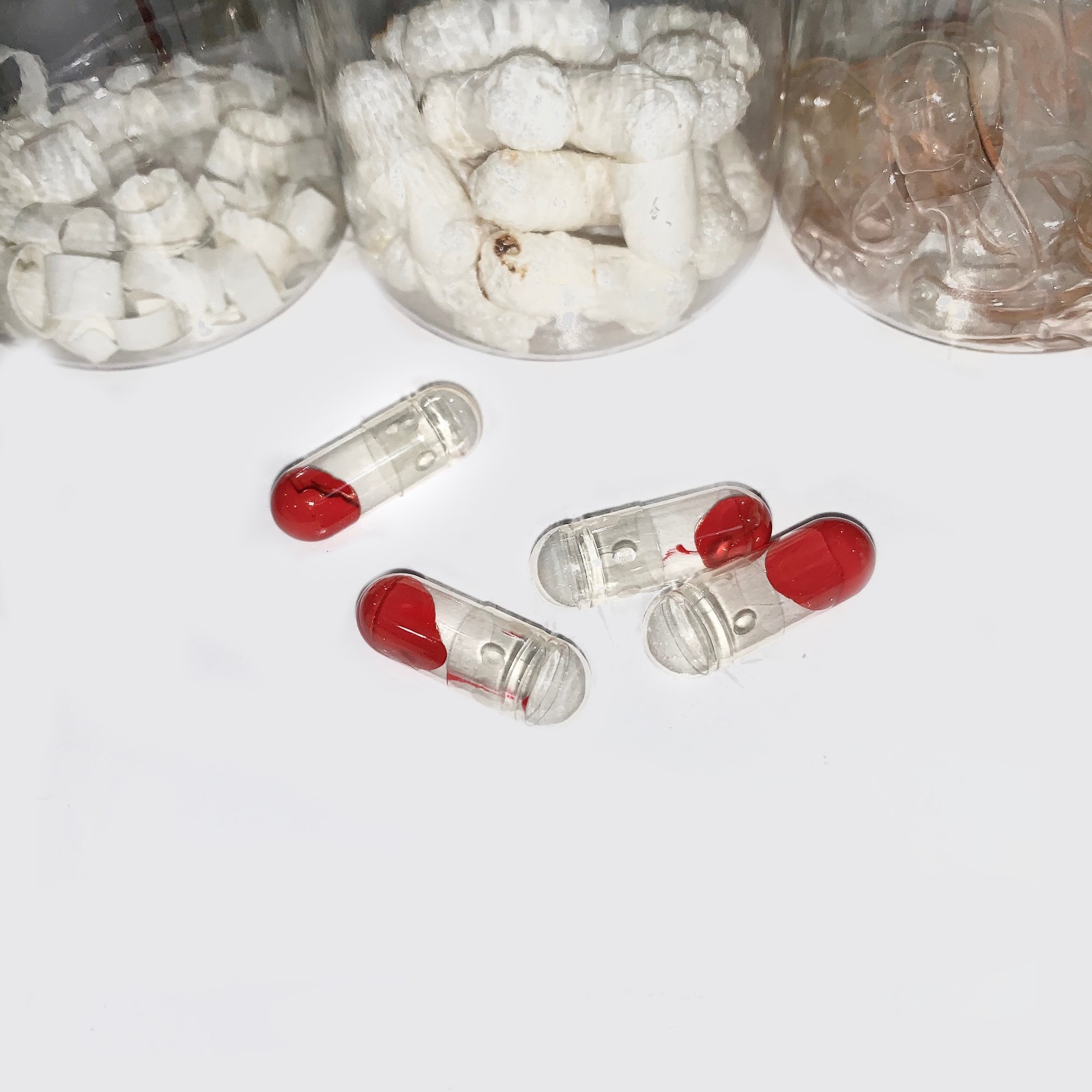
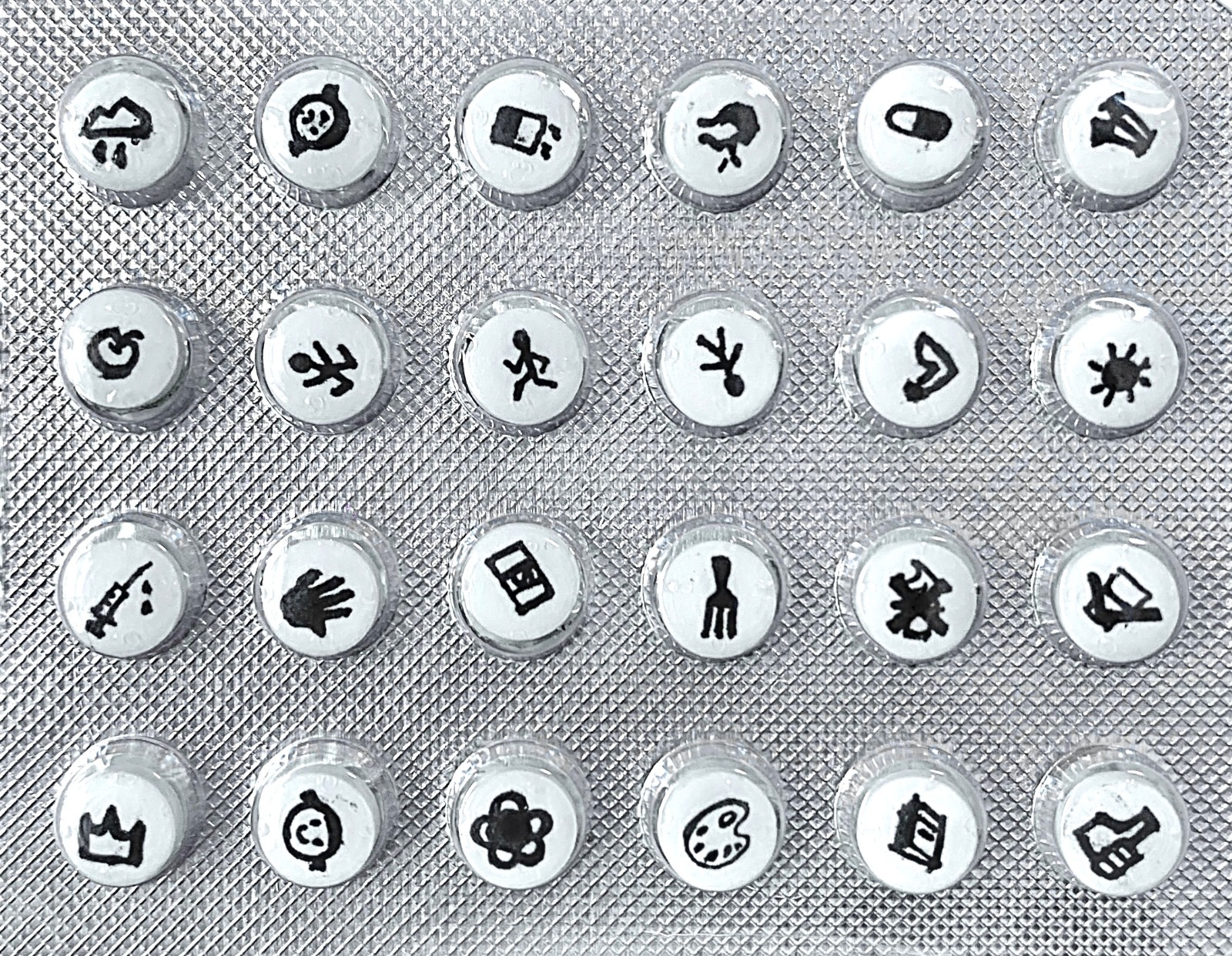
"Medicine", Materials: Capsules and Plastics, Variable Size
As for the work “nil ”, I would like to touch myself one step closer. This piece of work presents a different form from “Medicine”, however, it is consistent in terms of my emotion. In order to achieve the ideal rhythm and the expression of emotions, I attempted to edit the action and time repeatedly, which was challenging for me in terms of having to learn about the software and practice. Last semester, the art form we practiced used the copperplate as the medium. Everyone is the same in form, but the concept is different. Regarding this course, it expects us to be different in both concept and form, finding our own uniqueness to realize diversification. “Let materials represent ourselves”. I believe a good artwork is the coexistence of form and content. The form refers to the work’s materials and representation, while the content refers to its concept and idea. Besides, we must also consider what our work can reveal from a conceptual point of view. Instead of empowering great value to the work, we need to search for our nature and learn to analyze ourselves. Meanwhile, the depth and interest of the work are also worth thinking about—if it can step into the public vision and raise profound thinking? At the same time, enthusiasm for the work and investment in time is also an indispensable prerequisite for good work.


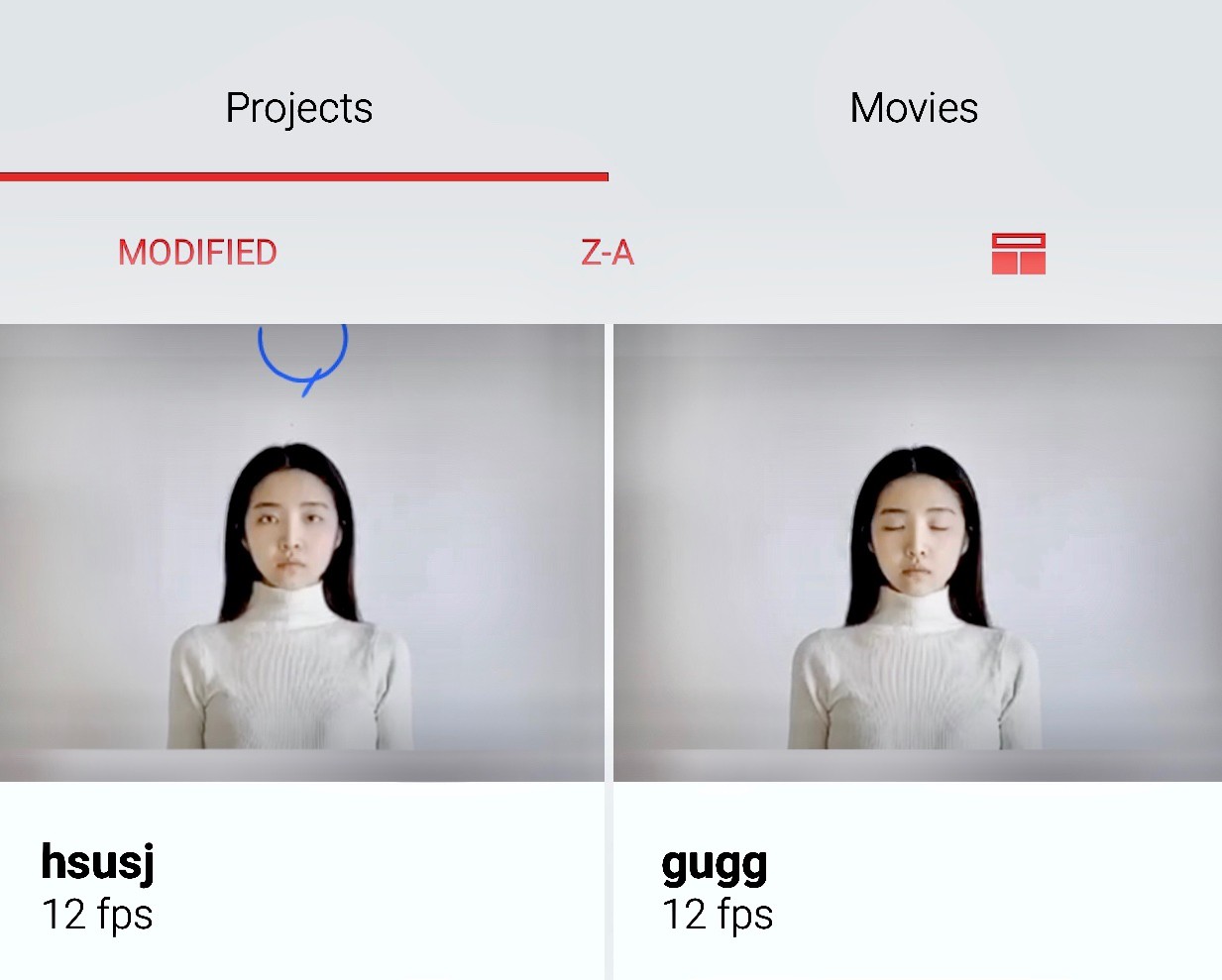
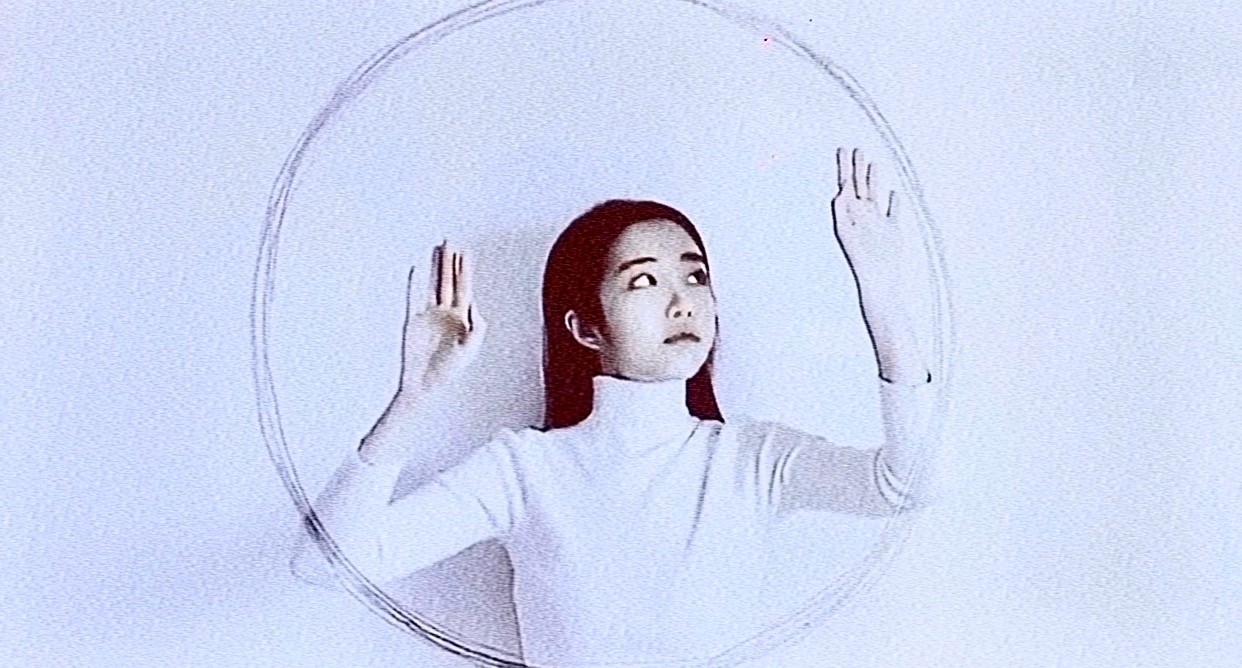

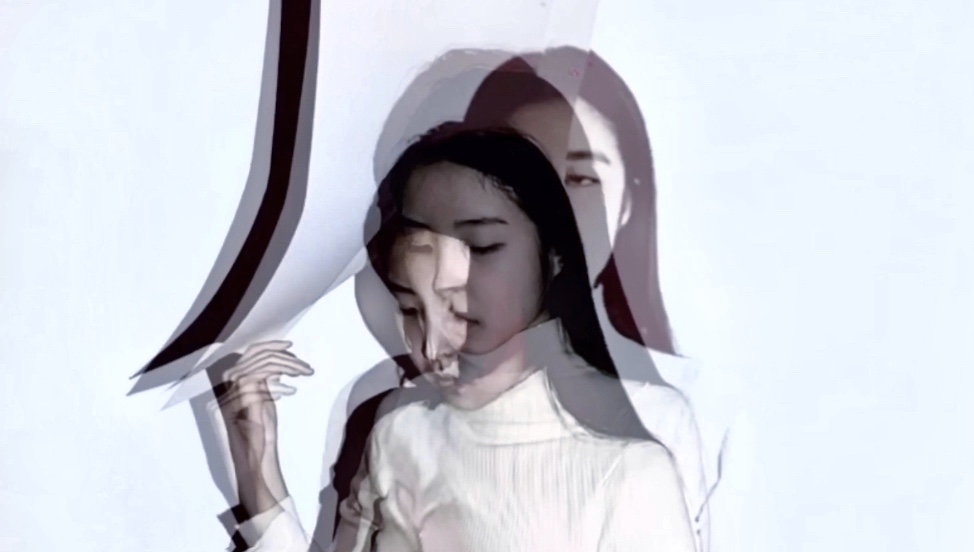


"nil", Projection Video, Variable Size
Zhang Zhandi: Based on your practical experience over these two works, can you tell us whether the concept and thinking of printmaking have somehow influenced your work? Maybe you need to think about it and talk as much as possible.
an Ge: Printmaking has indirectness, designability and pluralism. It is the most characteristic thing of printmaking that brings us a series of possible changes. How to transform it into our own things? I think we do not have to learn a lot of new knowledge, but to reintegrate the existing knowledge to form things that belong to ourselves. The method of integration is to explore and learn the different characteristics of printmaking in different media. For the work of “nil ”, I chose the medium of video and images, adding sound and projection to the time dimension of the video, presenting its 3D dimension in space, which allows its spread on the Internet and interaction on computers and iPads. At this time, the fundamental characteristics of printmaking have not changed. It is circulated on the Internet, and the pluralism is embodied in the modern printing industry and high-precision micro-injection technology or photosensitive plate making and computer engraving technology.
The current art creation is not merely two-dimensional paper-based and computer screen-based. It is also not the case that just creating work in a single dimension in 3D objects and cyberspace. The exhibition space is part of the work instead. If an exhibition space contains works with multiple media, such as paper-based, interactive video, video on the Internet, and 3D works that develop from paper-based patterns, all the concepts related to printmaking characteristics are concentrated in a piece of traditional printmaking which are once again grouped.
I think I should not be limited to printmaking, I can also choose oil paintings, mixed-media art, animation, or installations. There are two roads—“deep” refers to the depth of the technical spirit, and “wide” points to breaking the boundaries of printmaking, turning its limitations into its advantage, thus to realize to be unrestricted and free. When we have this concept, we can break the boundaries and use this restriction to create. It is primarily a change in the way of thinking, which leads to diverse expressive ways that present various features. It breaks the inherited tradition and subverts the rigid outdated models and thinking. However, the new technologies and methods may cause new restrictions as well, so breakthroughs are always needed and expected. This is the driving force for us to continuously explore ourselves and make innovations.
Student Xiao Yu
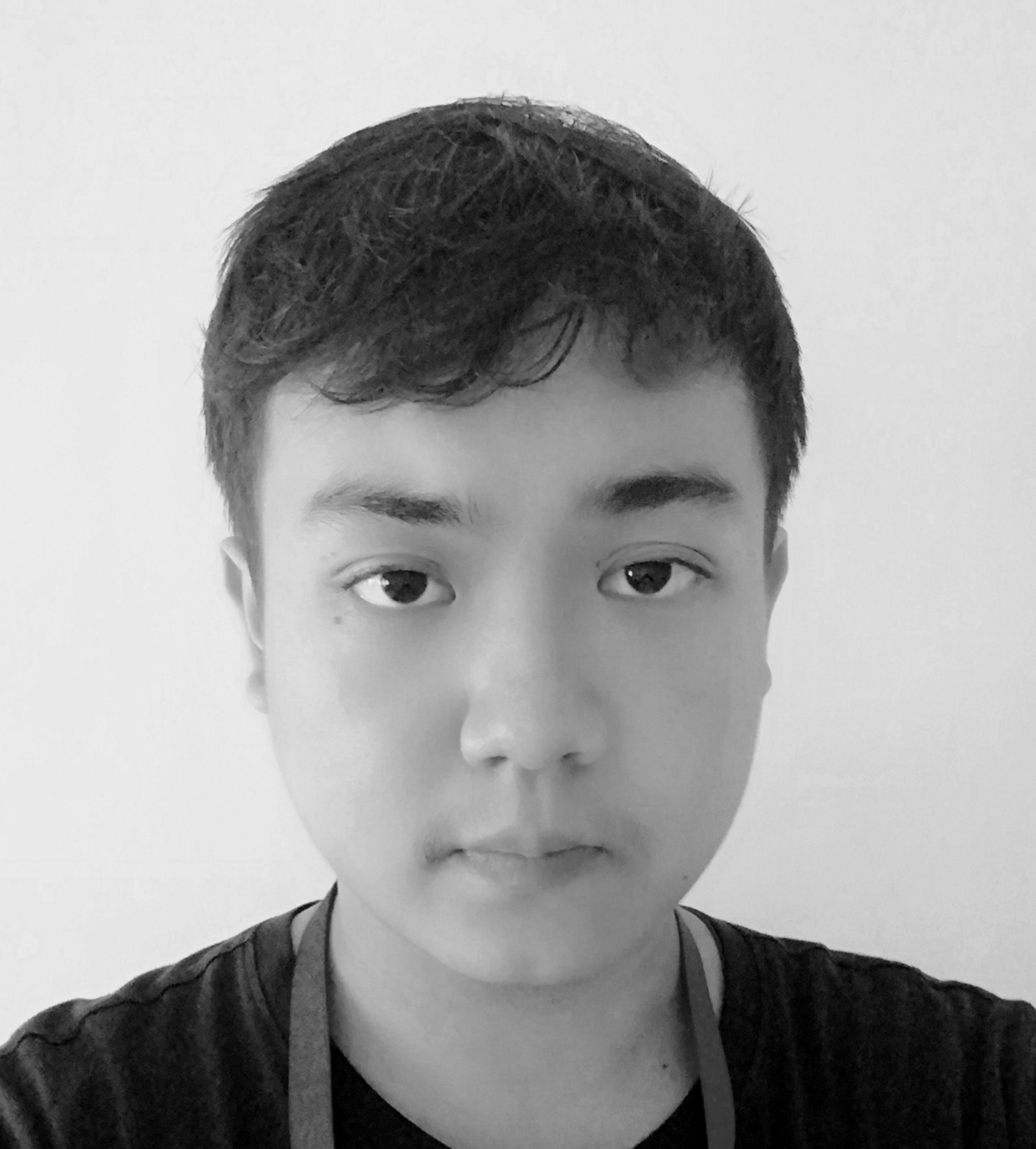
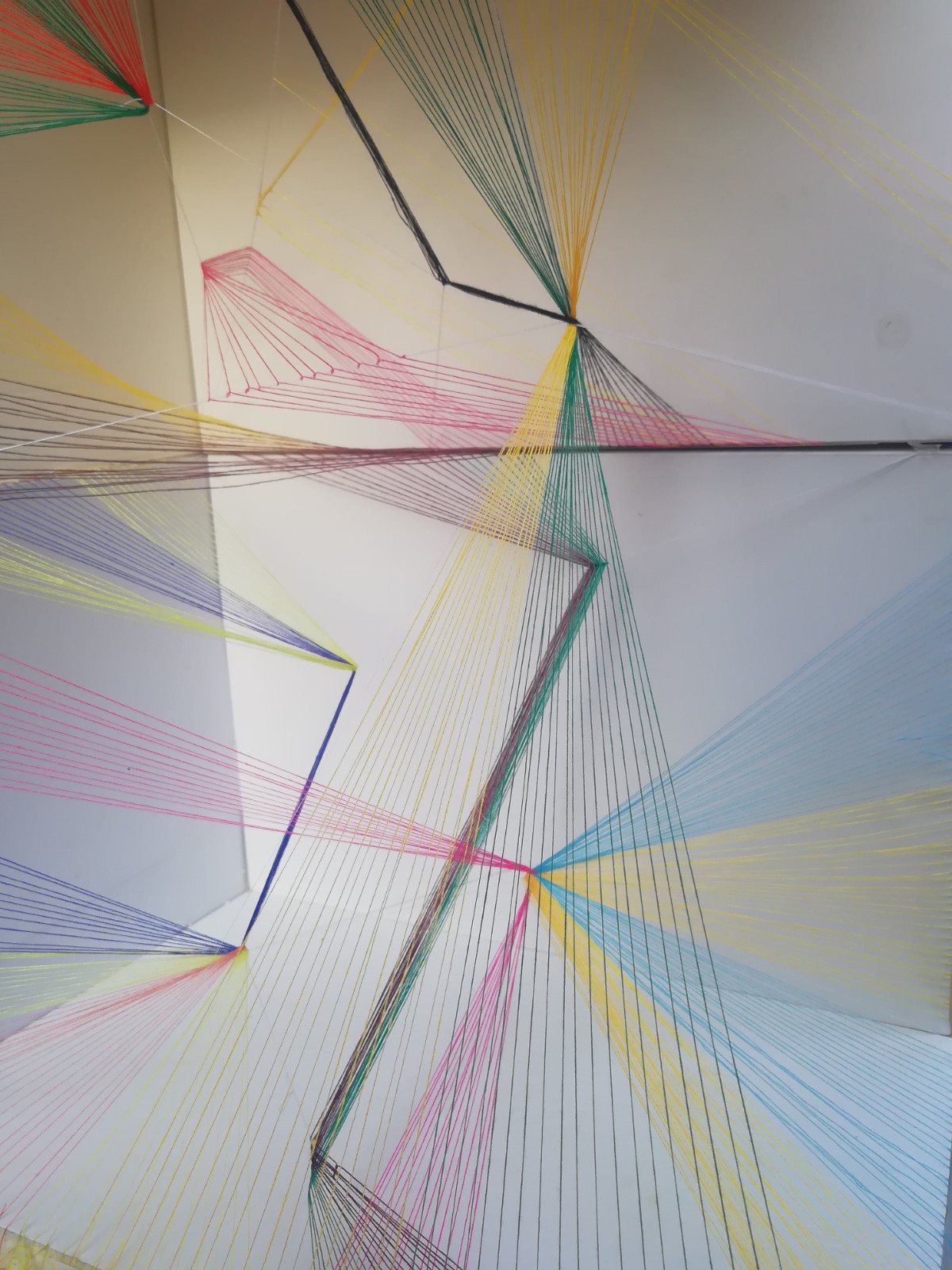 "Daily Material Research", Material: Darning Thread, Size: 90X30X40(cm)
"Daily Material Research", Material: Darning Thread, Size: 90X30X40(cm)
Zhang Zhandi: Your printmaking works in the last semester impressed me a lot, especially the part that was influenced by German Expressionism Art. Can you introduce your creative status at that time based on your interests?
Xiao Yu: I feel like, sometimes our creations are related to our emotions. In the last semester, I felt depressed for a while. I have tried some small drafts but they were insipid and cannot match my feelings and express myself. As time went by, I shifted my attention to expressionism works. The works that attracted me made me feel the strong emotions behind the artistic language. I touched something purer. I was fascinated by their free expression, strong and direct emotions. I previously attended a lecture on painting by a scholar at school. When he talked about Georg Baselitz, he said that the work was a direct expression of the individual’s spirit and soul, full of energy, no need for extra preparation, but just simplicity. These words also left a deep impression on me. I can't say that I understand this well, but I think some of the consciousness in it is something I like and want to a great extent. So in the process of making copper plates, I tried to do it in a different way, as much as possible to feel what I want in my heart, including my own emotions.
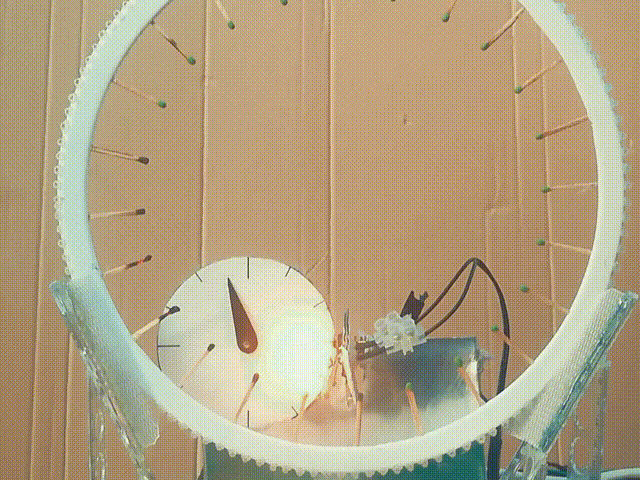
"The Erosion of Time", Installation, Mechanical Device, Computer Programming, Matchstick, Size: 50X40cm
Zhang Zhandi: Your work “The Erosion of Time” embodies a complicated conception and production. Please feel free to say something about this piece. What do you think is the most important point of this work for you?
Xiao Yu: Regarding this work, I would rather regard it as a practice for myself. Personally, the most vital thing should be, during the production process, it has trained me to think constantly and improved my hands-on ability. Because I have never tried any mechanical device, I think this subject has also taught me a lot. Some materials that were involved were the first time for me to use them, which led me to continue to study production with a strong interest. Failures were frequent, and there were always various problems in the production process, but I was not bored. I feel that when facing a subject, we must solve different things so that we can learn something new and accumulate our experience.



Creative Process of "The Erosion of Time"
During the production process, I also learned some basic principles, which was also good for me. Every link, connection, and control needed to be debugged repeatedly. From this, I also realize that it is crucial to continuously solve the current problems. In terms of thinking about concepts, it was a big problem before, and it was a difficult point. Later, I discovered that people inevitably face many problems from what had occurred previously. For me, during the pandemic, I often looked at the clock at home. Sometimes I felt anxious. Time was always passing by every minute and every second though it did not matter if I had something to do. For people, birth and death is an eternal law, which we cannot control. Time is eroding us.
Student Hu Jingzheng
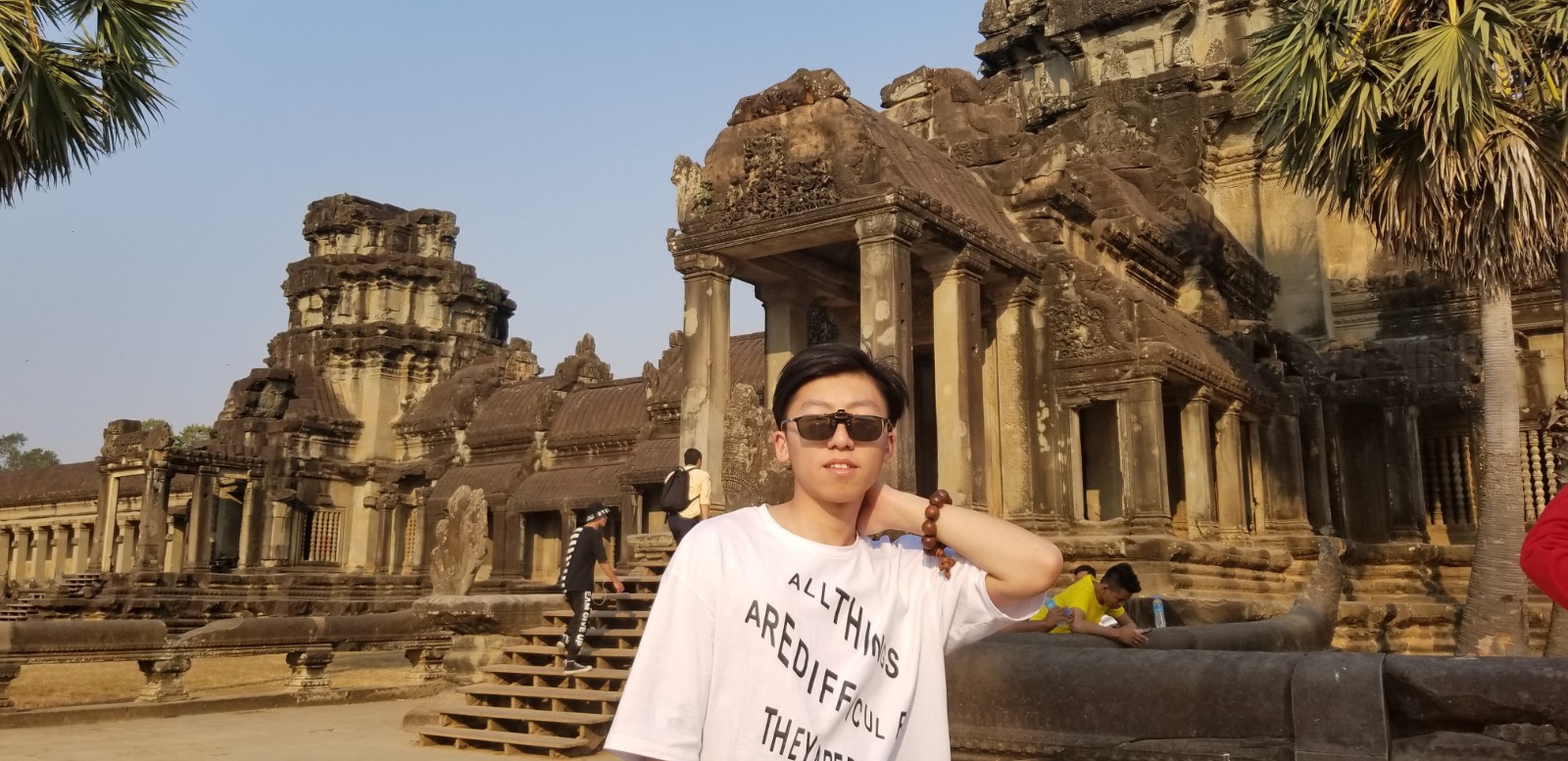



"Hole", Materials: Foam, Soft Mirror, Size: 1.2X1.5m
Zhang Zhandi: After the completion of the first work in this course, you still took time to adjust to it. I believe there must be something that interests you. Can you discuss it?
Hu Jingzheng: I am interested in time, space and physics, so my artworks are developed and researched in these fields. In the beginning, the artist I was very interested in was Escher. With deep research on Escher’s spatial expression and some abstract artists’ influence, I developed to form my own expression of space. At the beginning of this work, it was not very ideal. It started with the image of “door” as the creative element, then I developed the closure state of the door to express my creative intention. However, because the content format of this expression was too simple, and the story content I imposed was too much, the result in this work was not very satisfactory.
I used foam as the material, which was a cheap item that is commonly used for wrapping. I liked its smooth feel and special texture. I used an electric wire cutting machine to cut and shape the foam according to the adjustment of the machine’s rate of work. By doing so, I no longer deliberately created a specific shape and the individual elements created were more random, accidental and creative.


Hu Jingzheng was creating works at home.
Zhang Zhandi: This piece of work has been finished for a while. Can you sort out its concept and the relationship between the concept and the material?
Hu Jingzheng: The main theme of this work is “entrance and exit” and there is a confusion of choice, covering my exploration of the world and self-awareness, and the pursuit of time and space. In addition, the scene where this work is placed is in my bedroom. Through the reflection of the space in the mirror and the space between the works, space is stretched to a spiritual level, thus forming a conversation between the phenomenon and the spirit. The foam material represents a part of myself, it is cheap and ordinary, but it is pure and clean.



"Spinning Shadows", Materials: Foam, Soft Mirror, Strong Light, Dynamic Installation, Size: 2X2m
Zhang Zhandi: The second assignment has gone through many adjustments and additions. What have urged you to keep changing and advancing it during this process?
Hu Jingzheng: I believe that any work is constantly improved in the process of continuous advancement and change. Although the artwork is finally displayed by the results, I think the process is also very important. I think a good piece of work must be worthy of scrutiny. The process of deliberating and advancing is also a process of constantly sharpening oneself. In this process, I was also instructed and improved by my teacher. I understood the focus of my work on the form and concept, and I also got a deeper understanding of myself.
Zhan Zhandi: Besides, our course has a focus on the embodiment of the concept of printmaking in the work. Can you discuss your work from this perspective?
Hu Jingzheng: As a student of the printmaking department, my work naturally involves the concept of printmaking. Reproduction is a unique attribute of printmaking. In Andy Warhol’s printmaking, the image remains unchanged but the color changes, the enlarged and contractible images keep repeating. The meaning of the plural is no longer the result of a tooled mechanical repetition in the previously limited concept. Instead, “the charm of the plural is the profoundness in the change and the richness in the repetition.”
In this work, the reflection of the mirror surface has formed repeated but different images, which also form my understanding and application of the concept of printmaking. Through the reflection of soft mirrors, the continuous mirror surface makes the repeated image increasingly distorted, so that it becomes another image completely in the end. The concept of infinity exists, but it is puzzling. Is there an end to infinity? I think this is a different form of charm that replication brings to people.
Student Gan Zhuo’an
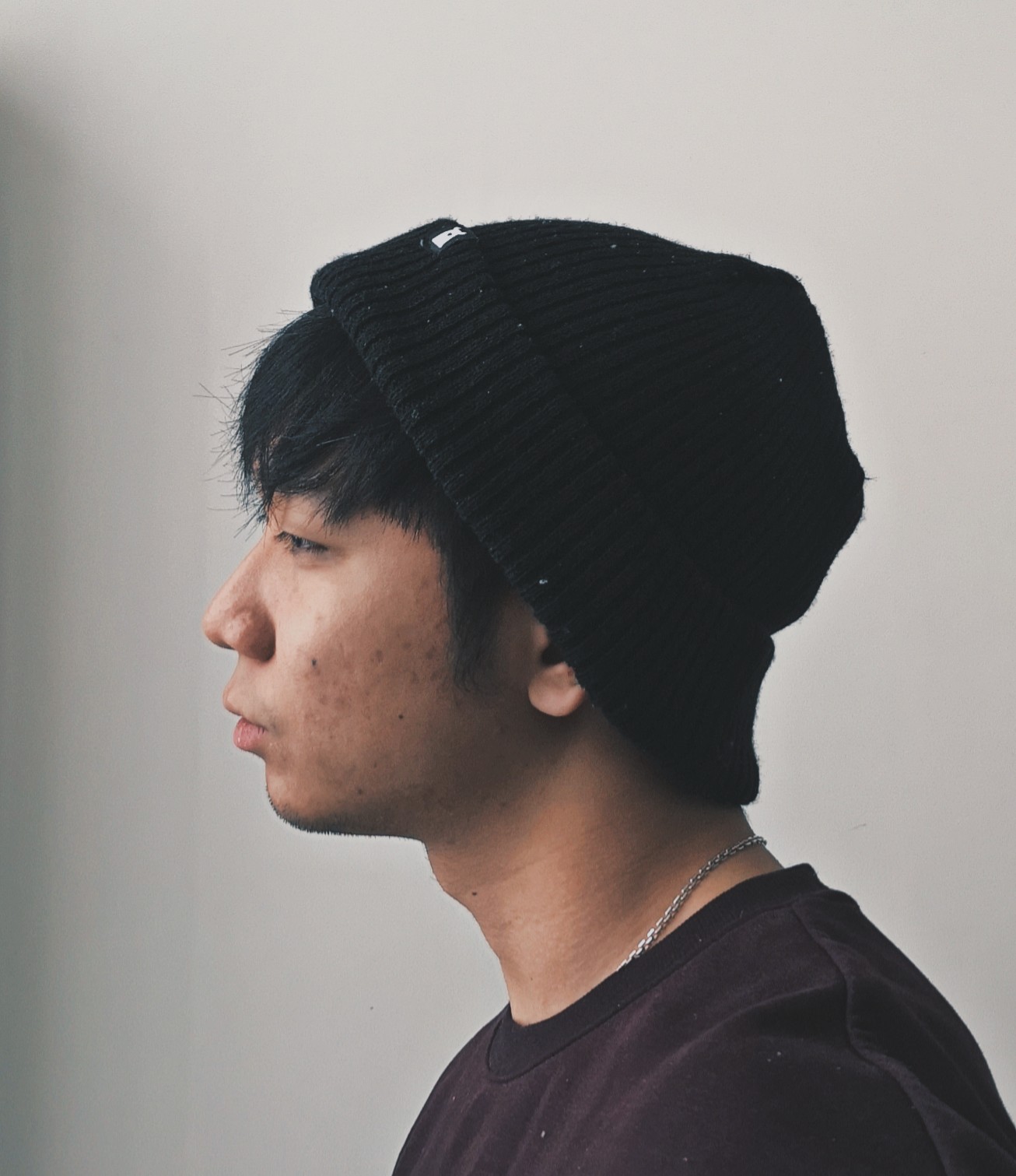






"I", Video, Duration: 3 hours 28 mins
Zhang Zhandi: You were in Beijing alone during the entire spring, and you created good work. More importantly, you tried to express by video. Can you talk about the idea for the first work, especially the idea of one person playing two roles, etc.?
Gan Zhuo'an: The work comes from a kind of emotion and feeling of myself during this period. Staying at home and being isolated led people to experience some new feelings. The root of this work comes from the loneliness and growth that many people would experience. In this time when everyone needs to be isolated, staying alone would either mean getting to know yourself better or become more confused.
There are changes in various thoughts about the current self, and I would consider the past more and look for a greater hope for the future. When I was a child, I didn't feel the support or respect from my family. Most of the reasons came from my poor study skill. As a first-generation ethnic Chinese, I was born and raised abroad. My family definitely hoped that I would be admitted to a good university and have a good job and promising future. I can now understand the distress, pressure and strict requirements at that time. This is the basis of how I connect to my work.
This video starts with my personal experience. From my point of view, I think that when I am ready to give up everything and leave this world, it is precisely when I feel strongest and greatest. Facing the one thing that everyone fears the most, namely, death and thinking about leaving the person I should love the most (myself) is so pitiful and sad, but I have grown up at that second. What my work is showing here is that time period. In this period, I had to battle with myself, in which a conversation and forgiveness were included. “What do I want?”, “what do I lack?”, and “what don’t I need?” All these topics are discussed in this video.
There are two “selves” in the work, and it also expresses that only “self” can save me. I can only make myself better. I am the most important person in my life. We always keep thinking, as insightful animals, we ought to look for a better life and self. In a word, this video concludes the process from losing to finding myself. As my first video work, I personally felt satisfied, after all, from shooting to editing, I completed everything with my mobile phone.
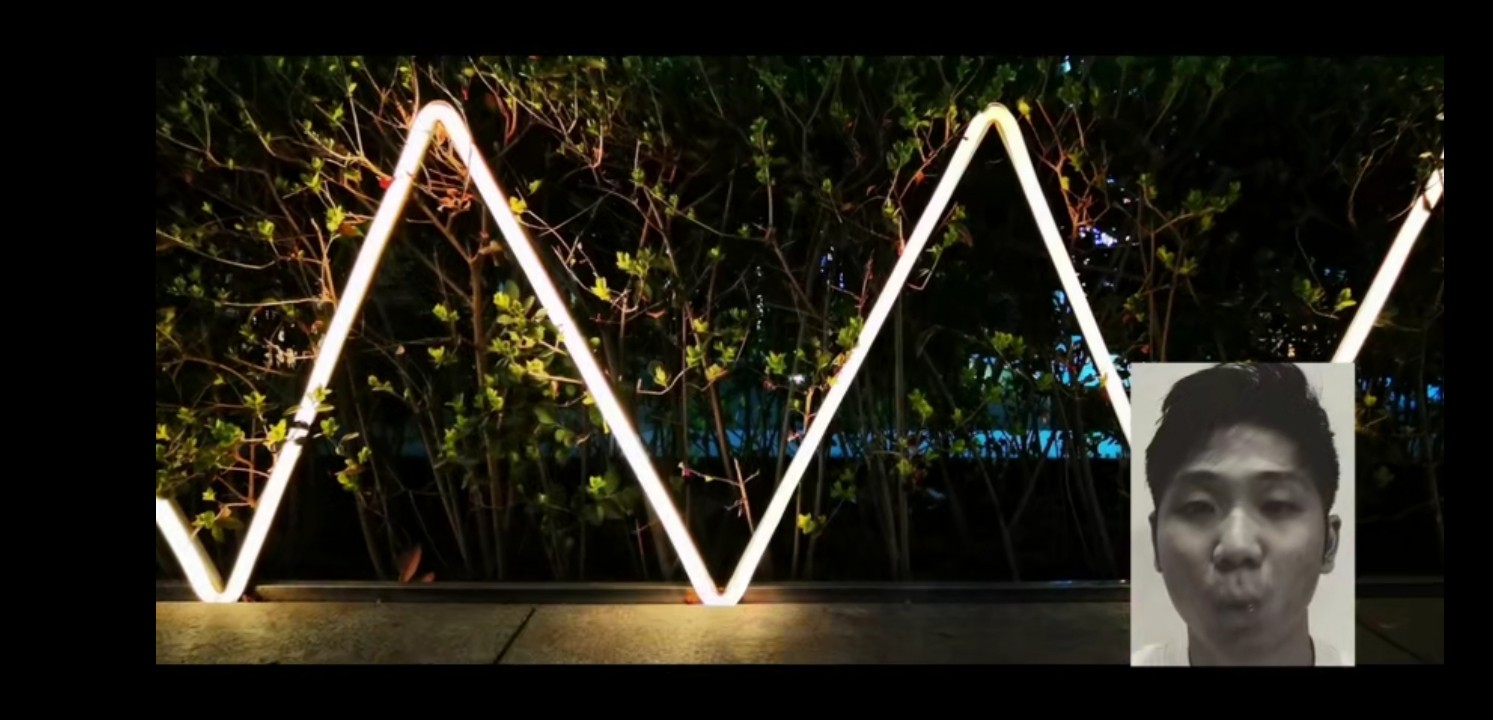
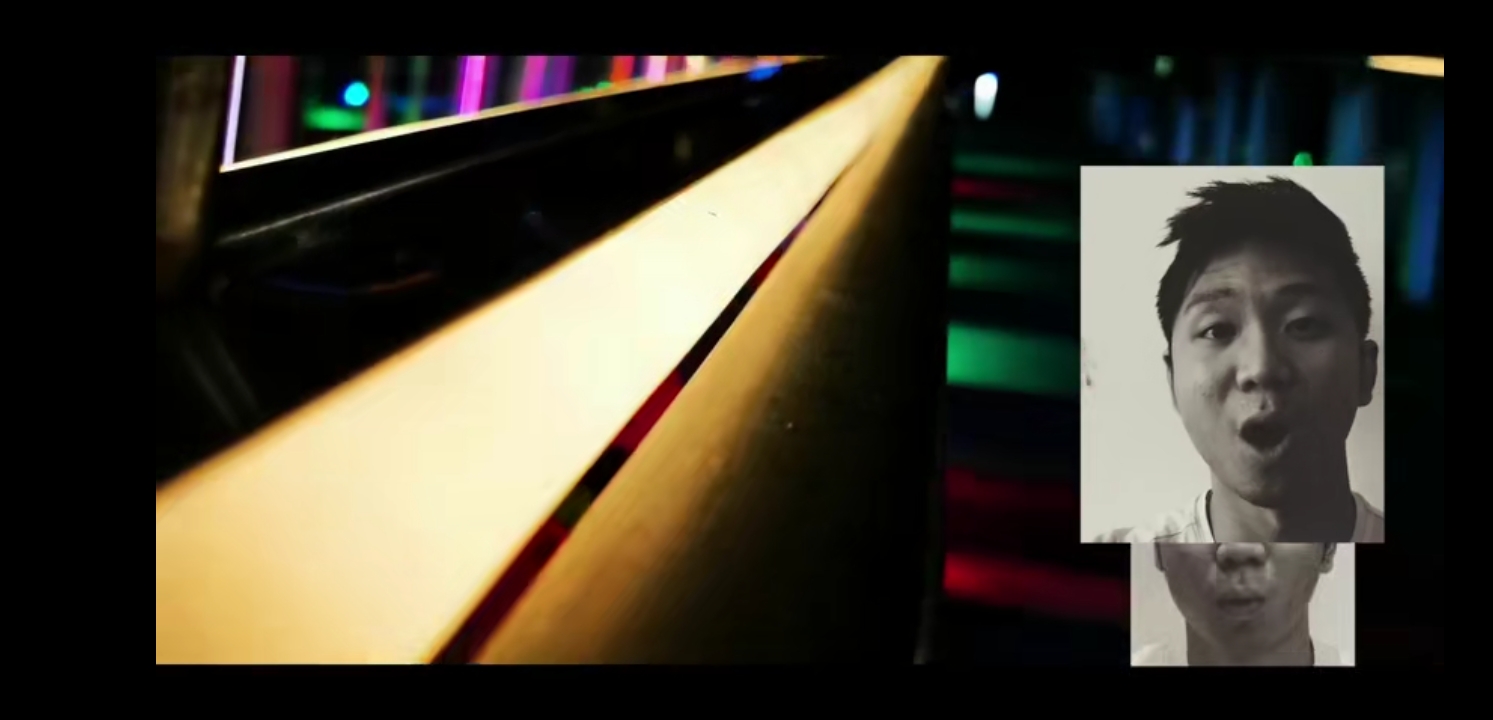


"Untitled", Video, Duration: 1 hour 11 mins
Zhang Zhandi: It seems that the second work is still unfinished but whether it is completed is not the most important thing, but the process that counts. You have indeed gone through a lot of thinking and adjustments. Let’s talk about the experience and insights during this creative process.
Gan Zhuo’an: In an unfamiliar and uncomfortable creative situation, I would learn a lot by myself, especially exploring my own views of myself. From going out to find material to performing and recording by myself, every step gives me a strong sense of freshness.
At the very beginning, I started with a fairly ordinary way of thinking, and I made three major adjustments to achieve satisfactory results. It was also because of long-term experiments that I found my own fun and interest in an unfamiliar medium. I think this is the greatest help that works have brought me, and it reminds me why we do art. Impressions, feelings, language, and ideas are all that the artist wants to express and present to others. The process of creating the video taught me this. The teacher has been guiding and supporting me and let me understand the most basic principles of creating anything. If you want to do one thing well, then you really have to stick to it and do it all the time. This is the biggest insight I have gained in this class.
Student Jia Min
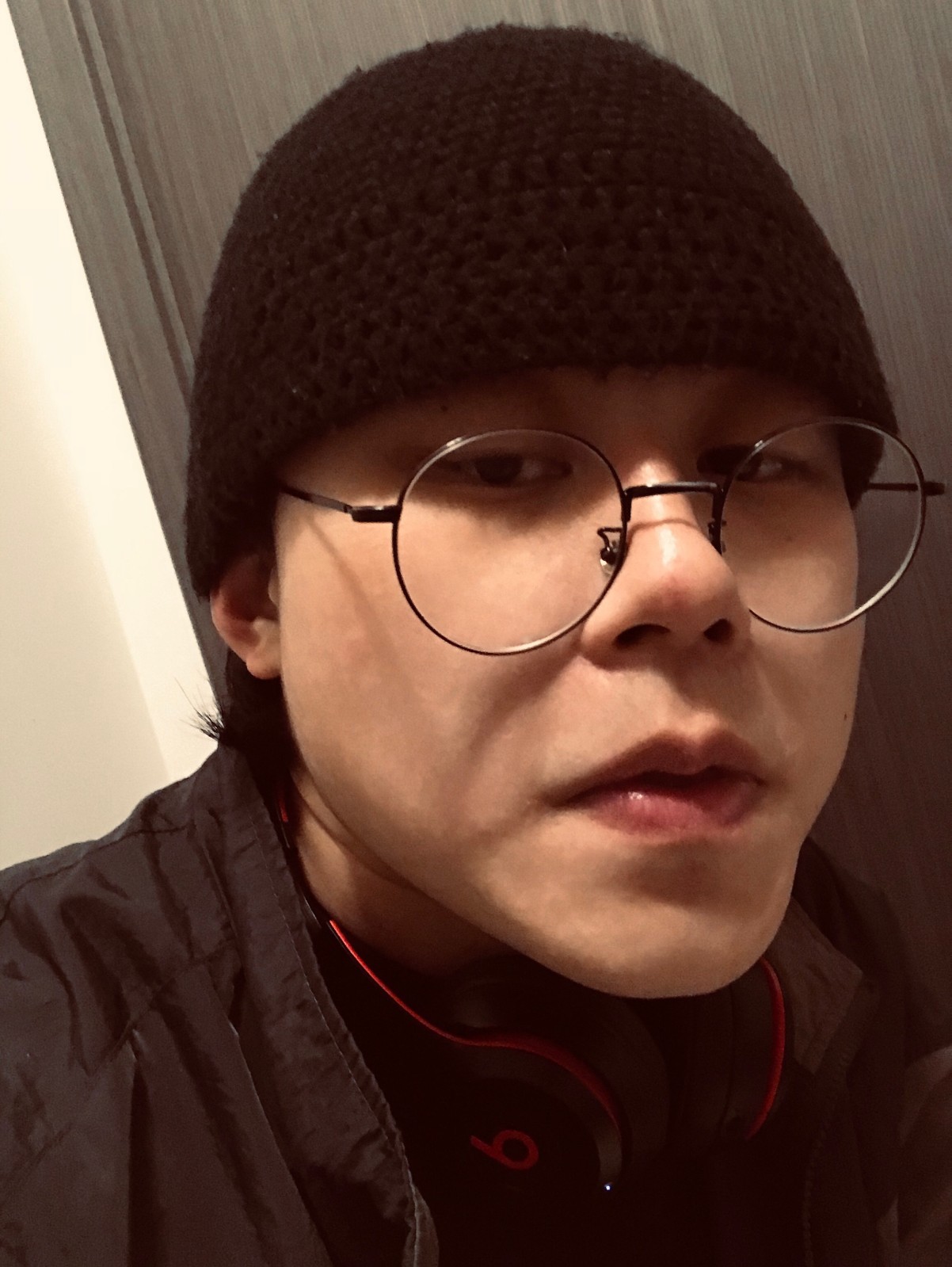
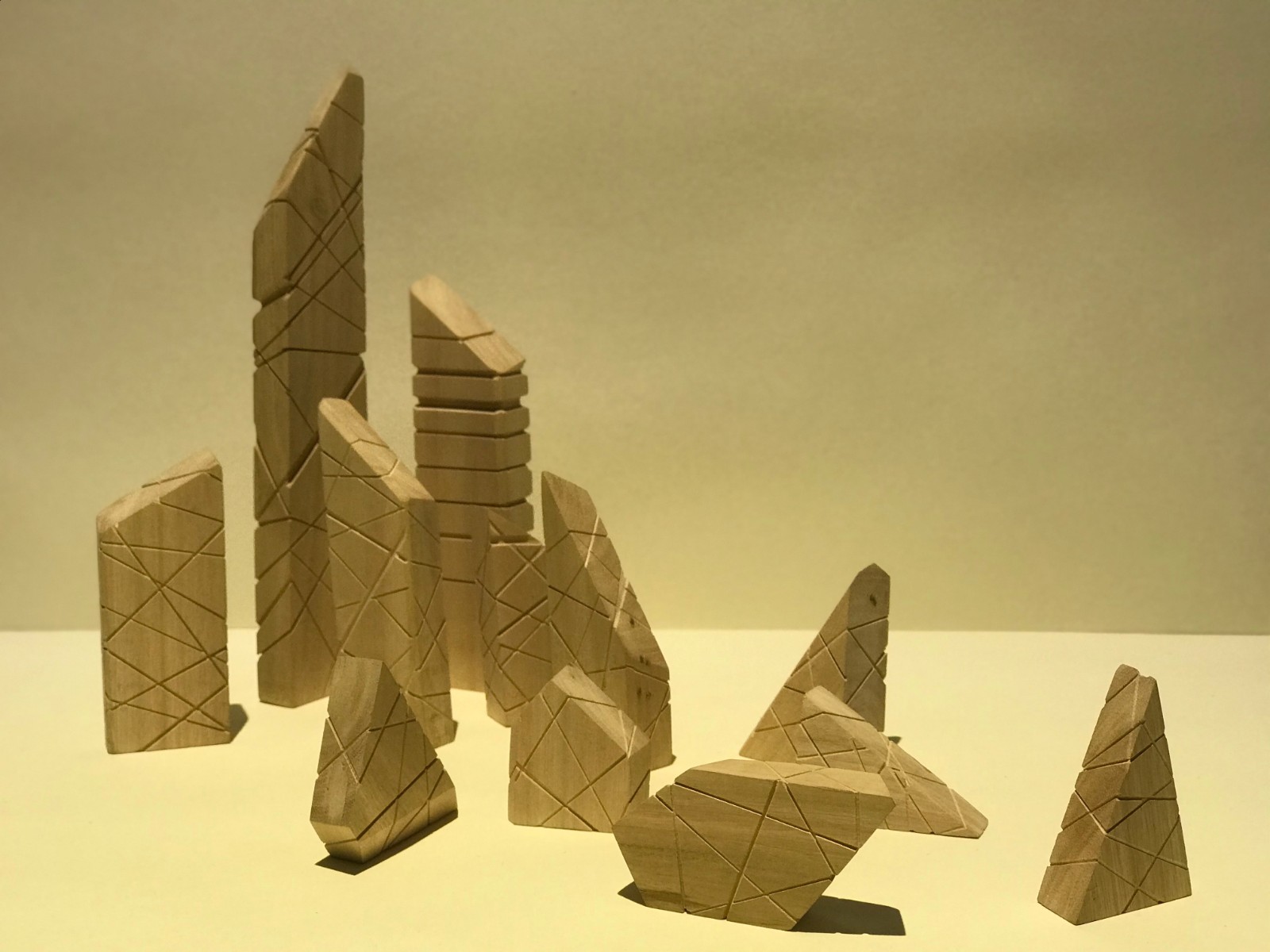

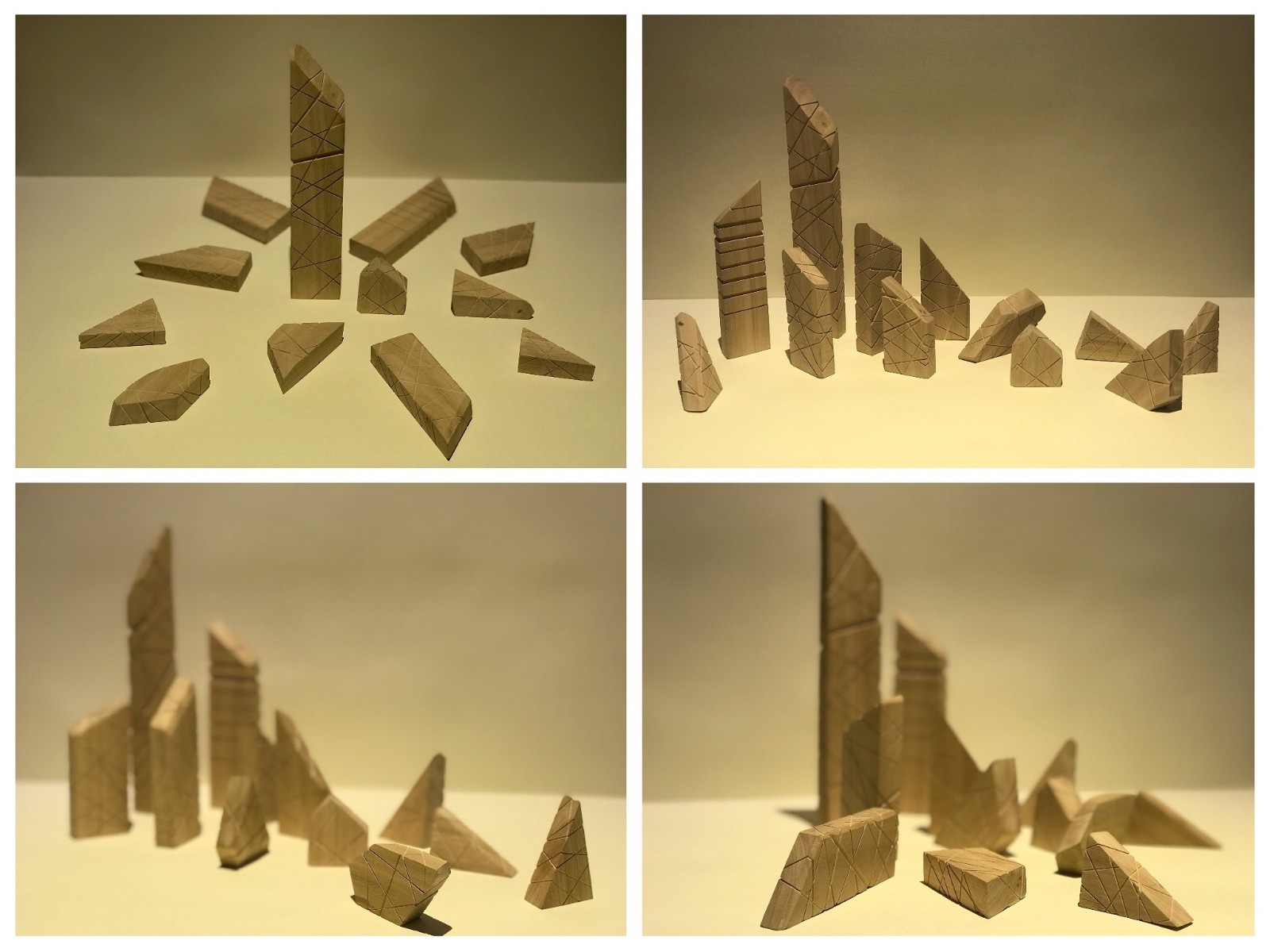

"Recombination", Material: Woods, Variable Size. The concept of "Recombination" comes from the previous Monotype and its working process
Zhang Zhandi: You showed great craftsmanship in your first work. Can you talk about your hobbies and whether your usual interests have an impact on the way you make your work?
Jia Min: LOL, yes. I usually like to collect some toy models, and I am especially obsessed with small-scale toy models, such as the Gundam capsule toys and the small-scale car models of Tomica Hot wheels. I love small and delicate things, and sometimes I will remake and repaint as well as making small crafts by myself, learning manual teaching videos on the Internet. I actually have a bit of obsessive-compulsive disorder. For example, like this work, I will polish every side and every groove as smoothly as possible. Perhaps these will more or less affect the way of creation and expression.



"Construction", Materials: Optical Fiber, Light Source, Home Environment, Variable Size
Zhang Zhandi: As we mentioned in the class that making a piece of work is often based on one's own creative interests to construct a work, which may not consider the origin of the printmaking concept. In fact, I think the embodiment and application of the concept of printmaking should be a subtle and natural process because we have done some printmaking before and have the knowledge and thoughts about it. So when we use other materials to make works, we will be affected by the intellectual framework of printmaking. Can you talk about how this work reflects it after the end of the course at this time?
Jia Min: Although there are no obvious printmaking forms in this work, the intellectual framework and concept of printmaking guides and supports it, especially the notion of “indirectness” that distinguishes printmaking from other art categories. “Indirectness” refers to the transformation process from “painting” to “making plates”, and to “artwork”. Compared to other art types, printmaking features the process of creation and labor. “Indirectness” not only refers to a process of making, but also raises requirements on creators in terms of their ideologies, concepts, emotions, consciousness, technologies, techniques and languages. From the initial conception of the drawing, the selection of materials to the production, to the presentation of the final work, the creation will be extended with the uncertainty of the production process.
The secondary creation was conducted during the process of selecting the material and medium based on the preliminary drawing. New creative inspiration would occur due to the specific material properties, and the presentation of the final work would be different from the original draft concept, which is an indirect manifestation.
The indirectness was also shown in my creative process of “l(fā)ight”. I made a comprehensive plan of material selection, concept and emotion input and the final presentation at the very beginning. However, it showed some differences from the plan when I realized the texture attributes of the materials I selected. The previous idea was to make a closed box to put the optical fiber into the box, but it was found that the effect presented would be different from the previous idea as the structure and volume were insufficient. In this case, on the basis of the original, I took advantage of the situation and carried out a re-creation, leading the optical fiber to extend to the outside of the box. By doing so, from the small space to the large space, I made use of the living space, giving full play to the characteristics of the selected materials, and used the element of light to connect with the daily space indirectly. Later, I found that the visual effects presented and the concepts I wanted to convey were stronger than before, and the sense of rhythm was also reflected. These are all manifestations of indirectness in printmaking. I enjoy this indirect creation process which offers uncertainty due to the attributes of materials. It brings up new inspiration and deepens my creation continuously.
Student Li Yuning





"Life", Mixed Materials, Plastic, Electrical Machinery, Variable Size
Zhang Zhandi: The scene of the first work left a great impression on me. Perhaps because it is so good to see plants on the beach during the pandemic. Is there anything else you want to talk about this work? What new experience do you have now?
Li Yuning: I am a native Cantonese. During the pandemic, people all over the country were experiencing quarantine. In previous years, I would usually walk on the beach when I returned home. At this time, I really expected and enjoyed the sea view, so I hope to create a work related to the ocean.
Initially, the motif I wanted to cut into in my creation was “l(fā)ife”. But for me, this was an obscure and elusive object. So I came to the place that I was familiar with and also gave birth to all life—I came to the beach. The COVID-19 virus was like a new life entity to us. It suddenly came to us and changed everything around us. We still can't predict what it will bring in the end. I brought this —the life entity created by me, came to the seaside, came to nature where we belong. I witnessed the juxtaposition with the life that has grown here for generations, exploring how to breathe slowly when surrounded by plants as if it blends into nature like the original life. But at this moment, as their creator, I don't even understand what they are and where they will go next.





"Sea Urchin", Animation, Variable Size
Zhang Zhandi: You have invested a huge amount of time to finish this animation work, and the final result was quite satisfying. Especially the structure of the work which is very good. Can you talk about the relationship between the structure and language of the work and the concept you want to express? After a discussion, some lyrical elements of music were reduced. What is the current view on this point?
Li Yuning: The image of the sea urchin is special to me. As a creature I have been in contact with it frequently since I was a child, it always seems to have a mysterious attraction to me. In my follow-up process of further understanding and creative practice of the sea urchin, I found that it is indeed a symbol that can serve as a carrier of my personal concept, so I continued to explore and experiment with this image.
The various images of the animation are all produced from the same “original version”, namely, the image of the sea urchin. Each different sea urchin image has a different meaning and personality, but they are all derived from the replication of the same mother sea urchin. When constructing the structure of the work, I also paid attention to increasing the overall sense of rhythm. These all reflect the pluralism of the printmaking and a sense of richness in repetition. In the animation, each step of the sea urchin would usher in a new stage, encountering different things, and eventually returning to the most original form. Although I used various forms of structure and language in this series of creations, they were constantly revolving around the motif of life that I wanted to cut into at the beginning. Regarding the modification of the music element, I also took teacher Zhang’s suggestions, so that the work can better eliminate interference and return to the theme. The content in the animation is partly related to dreams and myths.
Student Dong Qi


"Push stones up the mountain", Materials: Waste ceramic industrial products, Oil Painting Boards, Size: 18x24cm
Zhang Zhandi: I found that reading is a significant part of your work based on our daily communication. I even admire your courage and endurance to digest books with obscure and abstruse contents. Can you talk about the relationship between reading and your creation?
Dong Qi: Actually I hardly ever read before, so I was always confused by the completely unknown words mentioned by teachers in the class. Last summer, when I complained to a friend about being too bored, I was stimulated by her fulfilling summer vacation arrangements. So I decided to start reading and try my best to be “a person with knowledge”, and this habit persists until now. Reading some abstruse and incomprehensible books, besides the professional requirements, there is a saying that if you are accustomed to poverty, when you suddenly become rich you will immerse yourself in revenge spending. I have been lacking in knowledge for 20 years. I suddenly found that reading can be fun and can fulfill myself. So I always wonder if I can read more difficult books. Sometimes I read incomprehensible books many times before I understand them. After I comprehend them, there will be a sense of accomplishment, and I enjoy such a feeling.



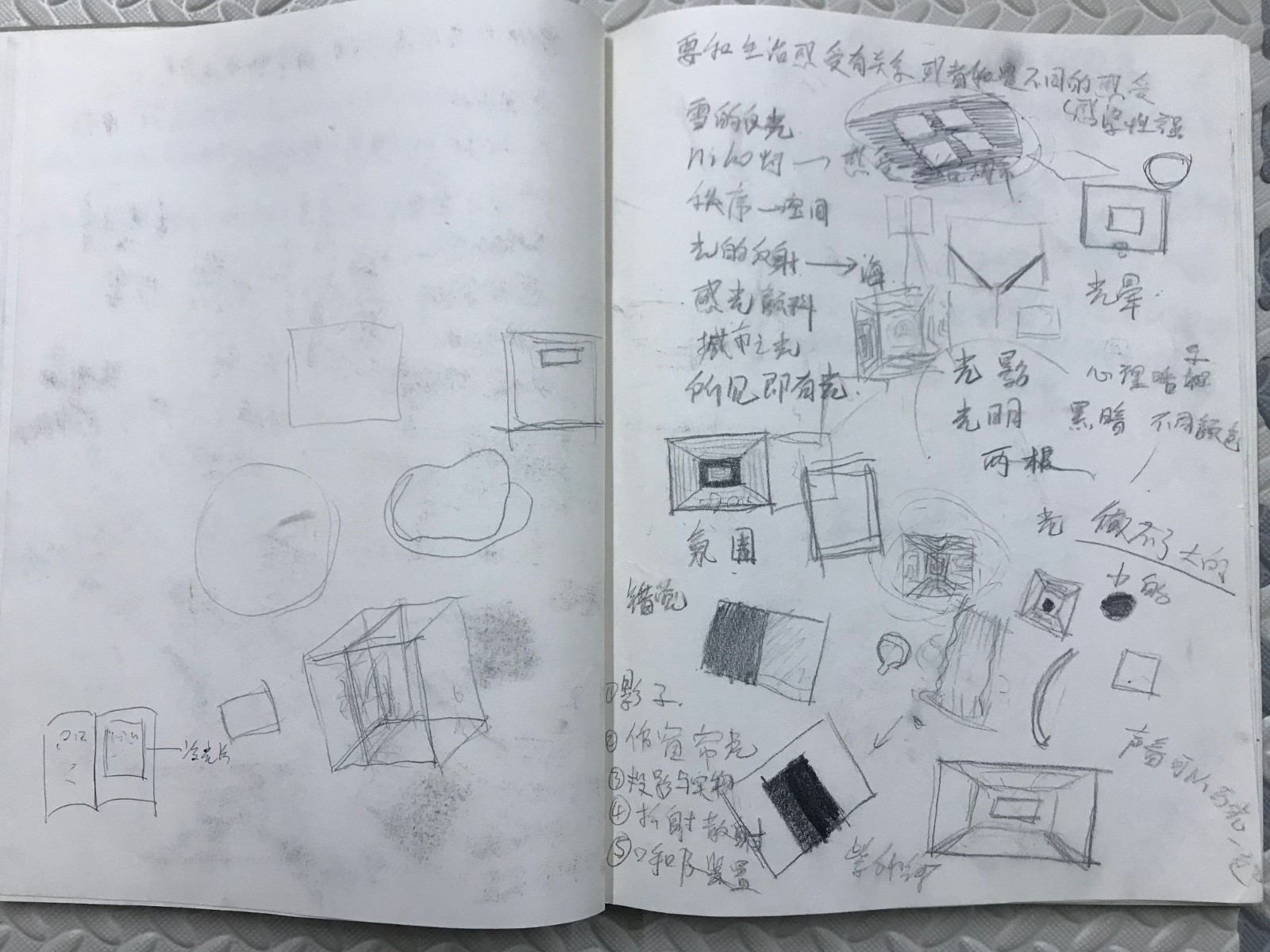
Dong Qi's Notebook
Later, I gradually discovered that the things learned in the book began to have a relationship with life, and I would have more doubts about things that I took for granted. I would think about them and then new problems are generated, which requires continuous thinking. These doubts and thinking later become the concept I want to express in my work. By doing so, reading in this way has something to do with my major. Reading books has also helped me develop the habit of writing down my thoughts. It is really much clearer to write down when I organize my thoughts. I also know that I still have lots more to read, so I arrange it in a very important place in my life. I am especially afraid to lose this habit.


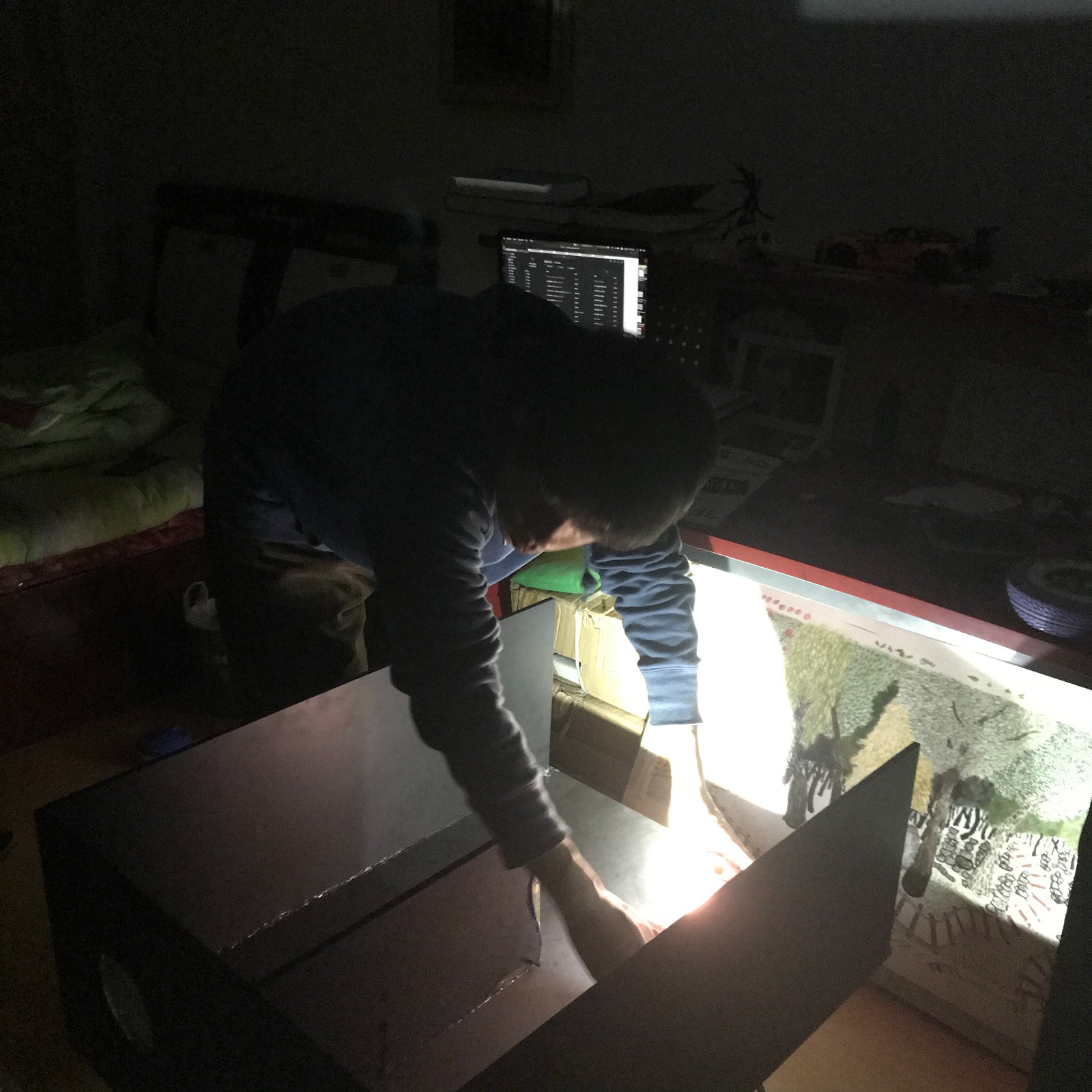
"Reflection", Materials: PVC Board, Glass Lens, Led Light, Apple, Paper, Size: 80x60x30(cm)
Zhang Zhandi: The second piece of work took a lot of energy. Frankly speaking, it was agonizing for a while as well. At the very beginning, you adjusted the form all the time. However, you finally took the concept of the work as the basis of the form. In this way, we both felt relieved. Can you talk about your thoughts about this process?
Dong Qi: I started the second piece from the material. I accidentally experimented with the effect of lens imaging, which was to clearly project the image of an object on the wall. I thought this unique effect can be used to make works. In the beginning, I decided to concentrate on the form. Then I fell into a long-term stagnation. There were actually two aspects to this stagnation. One was that I always thought that concepts and forms were equally important, and I could not accept the simplicity of concepts. Therefore, when thinking about the expressive power of the form, I always kept in mind the concept. The second was that I found that it could be replaced only from a formal point of view, and it was not unique enough to bring out the characteristics of this form.
These two things were tangled in my heart, and I felt dissatisfied no matter how I adjusted them. As time went by, the pressure was increased. I did not want to waste such a long time to create an unsatisfactory work. However, when I tried all the forms I could think of, I was still not satisfied in the end. So I put it aside and went out for few days to read and paint. At that time, I was reading “A History of Western Philosophy”. I found that in philosophy, many philosophers were unable to produce evidence and cannot be universally recognized, but many people are interested in topics such as the ideal world, the absolute spirit, the existence of gods, etc. There are still some problems that cannot be solved by in-depth thinking and research, and the meaning of some keywords is not even clear. How to understand the theory based on this then? Even the sensory organs that people use to perceive the outside world are deceptive. I started to think if we cannot fully understand the truth, what is the meaning of our current cognitive model of the world and the universe that may be incorrect for our existence?
When I was thinking about this issue, I suddenly realized that this idea can be combined with the existing form of my second work. So I decisively abandoned the purely formal direction and began to focus on concepts. I used the light and shadow images of the entity projected from the real object. This light image seemed to be recognizable, but at the same time, it was a one-sided reaction of the real object.
The question is, can we get an understanding of the entity from this one-sided reaction? What is the significance of this understanding? This is the concept I want to express. So far I feel that this work has a foothold in my heart. Another important reason for persistence is that Mr. Zhang was pressing me at every step of the way. The communication between us every time covered numerous ideas of exchange. It made me feel guilty every time I did not take it seriously at the very beginning. But I found that after the class, I can devote more time in working longer than before. I have survived the two months of suffering, and now there is nothing to be confused about!
The conversations between the tutor and students reveal the teacher’s experienced and careful guidance and inspiration. There are also internal motivations for young students to try to change themselves step by step. The transformation is not only embodied in students’ mood, but also the growth trajectory engraved through time. Starting from a common proposition, the students have applied their understanding to completely different creative approaches. This is also a manifestation of maintaining the diversified and personalized method of teaching.
Image and text courtesy of the teacher and the students.
Interviewed and edited by Zhang Yizhi.
Translated by Emily Weimeng Zhou and edited by Sue



























